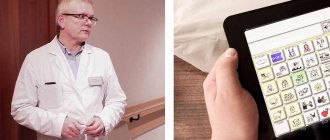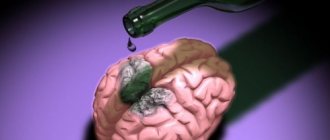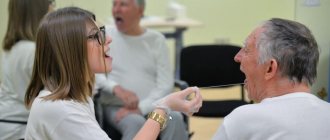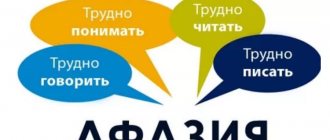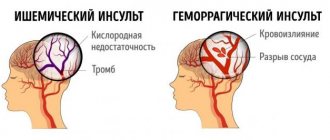Signs and causes of sensory aphasia
Sensory aphasia can result from a wide range of causes. This disease can be caused by both diseases of the cardiovascular system and traumatic injuries to the head and central nervous system. The most common causes of sensory aphasia are:
- Acute and transient disorders of cerebral blood flow, for example, embolism or hemorrhagic stroke. Embolization can occur as a result of the presence of an unstable atherosclerotic plaque in the bed of one of the carotid arteries or as a result of thrombus entry from the left atrial appendage in arthimogenic conditions.
- Traumatic head injuries, most often occurring in transport accidents. Contusions and traumatic brain injuries can lead to immediate damage to cortical and subcortical structures or delayed damage with the development of cerebral edema.
- Oncological processes localized in the cranium. Benign or malignant tumors can be a significant factor in the development of sensory aphasia.
It is important to note that the following branches entering the middle cerebral artery basin are most often involved in the formation of the lesion:
- Inferior branch of the middle cerebral artery;
- Posterior temporal artery;
- Artery of the angular gyrus.
Sensory cortical aphasia, Wernicke's aphasia, word deafness
Sensory cortical aphasia has several synonyms - Wernicke's aphasia , word deafness . Sensory cortical aphasia is characterized by a lack of understanding of the normal correct speech of others with preserved hearing. Patients with sensory cortical aphasia speak a lot, but their speech consists of a random collection of words and sounds. Sensory cortical aphasia is observed with damage to the posterior parts of the superior temporal gyrus of the dominant hemisphere. Sensory cortical aphasia is often combined with acalculia.
Forms of sensory aphasia
There are several significant clinical forms of sensory aphasia that are characteristic of sensory aphasia. When additional pathological foci of the cortical substance join the affected Wernicke's area, new symptoms of impaired speech function appear. In this regard, neurologists distinguish the following forms of aphasia:
Semantic aphasia
With this aphasia, there is a violation of the recognition of logic and the relationship of words and objects. This is especially true for spatial perception.
Acalculia-aphasia
In this case, the key symptom is the formation of a localized disorder of speech function. Namely, counting violations. At the same time, the patient’s other forms of speech are not affected.
Sensorimotor aphasia
Lack of speech awareness is associated not only with damage to the cortical part of the auditory analyzer, but also with a violation of articulatory function. In other words, a person cannot correctly evaluate gestures when pronouncing a specific word like another person. Same with myself. The patient himself is not aware of his illness and is very irritated in situations where he is not understood.
Total aphasia
With this option, the victim has a combination of different types of functional speech disorder. The patient has impairments in written and oral speech. In this case, the patient does not perceive someone else’s speech and also cannot answer anything himself.
What is Wernicke's aphasia?
20.02.2020
Aphasia is a disorder of language function that is localized in the dominant hemisphere of the brain . Traditionally, aphasia is classified as either expressive (Broca's) or receptive (Wernicke's) aphasia . Many patients have a component of both types of aphasia . This condition was first described by German physician Carl Wernicke in 1874 and is characterized by impaired understanding of language. Patients with aphasia speech understanding and therefore do not recognize mistakes made. The language function is localized in the left hemisphere of the brain in almost all right-handers and 60% of left-handers.
With aphasia , a person speaks fluently with normal speed and intonation. However, the content is often difficult to understand due to paraphrasing errors. Paraphasic errors come in two forms: semantic paraphasia errors, where one word is replaced by another, and phenomenal paraphrasic errors, where one sound or syllable is replaced by another. An example of a phonemic paraphasic error would be a patient saying “scales” instead of “clocks.” In severe cases, these errors can lead to neologisms (new words) or word salad, making communication almost unintelligible. Reading involves understanding written words, and therefore reading is also often impaired in aphasia . As with aphasia , repetition is also impaired.
Unlike aphasia , patients with aphasia speak with normal fluency and prosody and follow grammatical rules with normal sentence structure. Associated neurological symptoms depend on the size and location of the lesion and include visual , problems with calculation (acalculia), and writing (agraphia). Patients with aphasia often do not have the hemiparesis that accompanies language deficits. They also do not exhibit the same degree of emotional outbursts and depression as those with aphasia .
At diagnosis, the patient must be tested for every component of language, including assessment of verbal , ability to name objects, repeat simple phrases, understand simple and complex commands, read and write. When testing comprehension, it is helpful to start with simple commands such as “close your eyes” or “open your mouth.” This is followed by more complex commands such as “show me two fingers on your left hand” and commands that require crossing the midline such as “touch your right ear your left hand.”
Aphasia Examination is a widely used test to evaluate patients with language deficits. Formal neuropsychiatric testing may be necessary to identify areas of language deficit. Neuroimaging (CT, MRI, MRI, PET, or SPECT) may be required to localize and diagnose the etiology of aphasia .
aphasia must be distinguished from Alzheimer's disease . In both cases, patients may have trouble answering basic orientation questions. In aphasia , the key deficit is comprehension, while in dementia the problem is memory. Alzheimer's disease tends to be subacute at onset and progressive in nature, unlike aphasia , which has a sudden onset due to an ischemic stroke. Neuroimaging of the brain can help distinguish between the two conditions.
Published in Defectology Premium Clinic
Symptoms
Clinical manifestations of sensory aphasia have a number of specific signs that help make a quick and effective differential diagnosis. These signs include:
- Fluent speech or logorrhea, replete with a large number of allegorical expressions and paraphrases. The patient misses nouns, and I compensate for such speech defects with a large number of verbs, prepositions and conjunctions. Speech becomes verbose, but uninformative.
- “Jargnonic aphasia” is a continuous stream of neologisms, proverbs, sayings and paraphrases.
- Strong excitement up to the development of a paranoid state.
- Impaired understanding and perception of speech. The patient has difficulty or does not perceive simple questions at all, for example, a request to introduce himself or say who he is, but is able to follow simple commands, for example, turn his head or introduce himself. It is also important to note that the patient does not understand his own problem and becomes very irritated when the interlocutor does not perceive his speech well.
- Right-sided hemianopsia or upper quadrant hemianopsia. Loss of visual fields - when reading books, the victim will completely not notice the left page when reading the text.
- Smoothing of the nasolabial fold - the face becomes like a mask.
- Impairment of written speech.
There is also pure sensory aphasia (subcortical), when only the understanding of oral speech is impaired, but the understanding of written information, and therefore what is read, is preserved. Another form is also distinguished - transcortical sensory aphasia, which is characterized by the preservation of the ability to repeat oral speech, despite the lack of its perception and understanding. The main problem is that the patient hears the address to himself, but cannot interpret the meaning of what the interlocutor said. The native language is perceived as if it were foreign.
Sensory aphasia in rare cases occurs as an independent lesion of the auditory zones located in the brain, since in almost 85% of cases the damage involves several areas of the brain responsible for a wide variety of functions of the victim’s body. For example, with a stroke, sensory aphasia is often combined with paresis or paralysis of skeletal muscles on the side opposite the lesion. In the case of an infectious-inflammatory process: abscess, meningitis, encephalitis, there will be signs of general intoxication of the body and febrile syndrome, as well as cerebral symptoms. In the case of encephalitis, specific changes will be added to the cerebrospinal fluid - cerebrospinal fluid.
Specific signs of sensory aphasia in children
Sensory aphasia in childhood can be confused with alalia - the primary absence of speech, but there is a difference: if with alalia speech does not shift from the initial level of development, i.e. does not progress and does not undergo regression, then with aphasia a sharp degradation in the development of speech function, which has already been formed in a person, is noticeable. Since in childhood the speech function is not yet fully formed, there are specific signs for aphasia:
- As a rule, there is a rapid development of the disease and rapid recovery of speech function. Lack of recovery progress over several weeks is a poor prognostic sign for further recovery and indicates more serious brain damage.
- Restoration of speech function is carried out by increasing the activity of neighboring areas of the cortex, which to some extent are able to compensate for the neurological deficit. In adults, the restoration of speech function is carried out due to the formation of new logical connections and a developed conceptual apparatus.
- Scanty symptoms. Very often, it is difficult to determine the specific type of aphasia in children, since their speech function is not sufficiently developed. As a result, the conditions for revealing the full clinical picture of sensory aphasia are not created.
How does sensory aphasia occur in childhood?
Sensory aphasia in children occurs quickly, but after eliminating the factor that damaged the brain, speech is also quickly restored, because it is easy for the child’s brain to develop new connections to replace the lost ones. It is worse if speech has not been restored several weeks after the event that led to its loss. In this case, the forecast becomes worse.
When diagnosing children, it is easy to confuse aphasia (loss of speech skills) with alalia (their immaturity). Anamnesis will help to distinguish between the conditions: were there any traumatic factors at what stage of the child’s development before them?
Diagnostics
Diagnosis of sensory aphasia is primarily aimed at identifying the cause of the disease. The diagnostic study must be comprehensive and consist of the following stages:
- Consultation and questioning of the patient to determine the history of life and illness. Also, during the initial appointment, the doctor examines the patient and studies specific symptom complexes. The neurologist looks for concomitant diseases that manifest themselves not only by external signs, but also by conducting additional tests and studies. During the examination, a specialist neurologist determines the lesions, the nature and course of the pathological process, assesses the general condition of the patient, as well as the blood supply to the brain. Makes a prognosis and subsequent treatment plan in accordance with the patient’s age. Its individual characteristics and concomitant somatic diseases. As well as the level of damage to the central nervous system.
- Consultation with a speech therapist, psychologist and other specialists. They determine the severity of the speech function defect and coordinate further tactics for restoring lost functions with the attending physician.
- Conducting additional instrumental and laboratory studies to verify and clarify the clinical diagnosis. Studies such as computer and magnetic resonance imaging, electroencephalography, angiography of cerebral vessels are carried out. These studies are carried out to identify the level and area of brain damage, the presence of space-occupying formations in the nervous tissue, aneurysms and hemorrhages in the brain tissue, foci of abscess, and the consequences of a stroke.
Instrumental diagnostics
To make a correct diagnosis, instrumental diagnostics is necessary. The patient is prescribed electroencephalography. This is a technique for studying the electrical activity of the brain by placing electrodes in specific areas on the surface of the head.
To clearly see the structure of the brain, to identify traces of hemorrhages, inflammation, and malignant neoplasms, computed tomography (CT) or magnetic resonance imaging (MRI) is prescribed. If it is necessary to clarify the integrity of blood vessels, identify aneurysms and other vascular disorders, then angiography may be required. Carrying out a comprehensive diagnosis makes it possible to differentiate aphasia from alalia, hearing loss and other pathologies.
Treatment of the disease directly depends on the form. It takes a long time to restore speech. It depends on a number of conditions: the cause of its appearance, the exact location of the damage, the degree of speech disorder, and the age of the patient.
An individual treatment plan is developed for the patient, which pays attention to drug therapy, physiotherapy, art therapy and classes with a speech pathologist. Drug therapy includes the prescription of antibacterial drugs, nootropics and other drugs (depending on the clinical picture). For example, in case of massive pathological changes that cause vasogenic edema, the doctor prescribes corticosteroids. To prevent epilepsy attacks, it is necessary to take anticonvulsants.
Exercises for correction
For some, it is easier to start pronouncing sounds and then move on to more complex words, while for others, on the contrary, it is much easier to say words and then isolate sounds. There are many exercises that significantly contribute to the correction of the disease. If you have problems understanding speech, it is recommended to first take three steps:
- Show in the picture where a specific detail of the image is located.
- Answer simple questions. For example: “Are you sitting on a chair now?”, “Are you walking in the fresh air now?”
- Take simple steps. For example, open a notebook and clench your fist.
This is an approximate plan; a speech pathologist-speech pathologist may give other tasks. In this case, the main thing is that the person learns to understand what is required of him. Articular gymnastics are often performed. A speech therapist teaches a person the correct pronunciation of sounds and composing phrases using special exercises. The doctor carries out work aimed at remembering the names of various objects and their purposes.
Treatment
The treatment process aimed at restoring the consequences resulting from aphasia requires a long time and enormous dedication, both from the patient and his relatives, and from medical personnel and specialists who have undergone special training. The restoration work of such a pathological condition consists of the following points:
- Pharmacological (drug) therapy. It mainly includes the use of drugs from the group of nootropics, drugs that increase the metabolism and trophic potential of the brain, vitamin therapy with neuroprotective B vitamins. Additional therapy is selected individually and prescribed in accordance with the cause of sensory aphasia. For example, in the case of a stroke, thrombolytic or hemostatic drugs are added, in the case of an infectious inflammatory lesion, antibiotics, non-steroidal anti-inflammatory drugs or antifungal agents are added.
- Session with a speech therapist. The main difficulty that arises when attempting to contact the victim is the lack of understanding of the specialist’s approach to the patient. Violation of communicative activity requires long-term correction and perseverance. There are also difficulties in interpreting what the patient says. Because his speech is uninformative. It is very difficult to identify the main idea. Consultations with a speech therapist help restore the patient’s vocabulary, correct pronunciation of sounds and meaningful speech. With the help of special exercises and equipment, you can actively interact with the patient even at home.
- Surgical interventions. In some cases, with deep or severe brain damage, the patient requires emergency surgery to eliminate the threat to life. In case of an aneurysm, clipping or sclerosis of the aneurysm can be performed using X-ray control. If aphasia is caused by tumor growth, then stereotactic surgery can be performed to destroy the tumor focus.
- Additional treatment methods can speed up the recovery processes in the victim’s nervous tissue, and also increase the effectiveness of the main therapy. In the treatment of sensory aphasia, methods such as physical therapy, massage, physiotherapeutic methods, and the use of computer programs that stimulate the speech center and improve speech abilities are used. A positive effect has also been noted in contact with animals, so the following can be used in therapy: hippotherapy, feline therapy and dolphin therapy.
At the Clinical Institute of the Brain there is a specialized rehabilitation and recovery center that deals with the correction of disorders in patients with aphasia. Together with treatment, we manage to achieve a quick, step-by-step recovery process. There is a close connection between treatment and rehabilitation, which helps to quickly adapt the patient to new living conditions, thereby significantly increasing the effectiveness of therapy and recovery.
Motor aphasia
- The motor group includes various forms of aphasia, which are united by the main characteristic of this type of disorder - the absence of active oral speech.
- Efferent - a disorder of articulation in which a person cannot freely move from one sound to another. This type of pathology is characterized by uncontrolled speech, which may consist solely of a random set of sounds and words. Speech becomes scarce, patients may not use prepositions and always use the same case. In severe cases, the ability to read aloud is lost.
- Afferent - a violation of articulation, in which a person cannot determine what needs to be done to pronounce a particular sound. Patients confuse sounds that are similar in pronunciation (“z” and “s”, “b” and “p”, etc.), and during speech they can rearrange or skip letters, syllables or words.
- Dynamic - symptoms include a “telegraphic” style of speech, long pauses between words, lack of prepositions, disruption of the usual rhythm, blurred articulation, involuntary transition to a whisper. Typically, patients have reduced speech activity, as if they do not want to engage in dialogue.
Different types of aphasia rarely occur separately from each other; usually the disease has a mixed form. One of its varieties is total, characterized by a complete loss of the ability to speak and understand speech.
Rehabilitation
Only daily classes with a speech therapist and other specialists will contribute to an active rehabilitation process. It is very important to correctly build a rehabilitation plan from simple to complex. To begin with, the victim must be adapted to new conditions. Only after a course of psychotherapy can one begin rehabilitation measures, since the patient must be motivated to recover.
The patient can also perform the following exercises at home:
- Simple questions: the patient is first asked questions with monosyllabic yes or no answers, then later they move on to open questions.
- Thematic dialogues are practiced with the gradual development of dialogue on specific topics;
- Writing and reading. Correction of the spelling and pronunciation of letters begins. Then syllables, which the patient then puts into words. In the future, with successful progress, they move on to writing dictations and reading short texts. The patient is asked to retell in his own words the story he read and answer questions about its content;
- A task aimed at matching pictures and text. The patient is asked to build a story, while laying out the pictures sequentially;
- Structuring pictures according to general properties and characteristics. The patient is given the task of arranging the pictures according to categories and highlighting common characteristics, for example, to separate some animals from others.
Clinical Brain Institute Rating: 4/5 — 12 votes
Share article on social networks
Motor cortical aphasia (Broca), verbal, expressive aphasia
Motor cortical aphasia is characterized by impairment of oral speech, writing, and reading. Motor cortical aphasia occurs when the posterior parts of the inferior frontal gyrus of the dominant hemisphere are damaged. In mild forms, speech is slow, ungrammatical, the construction of phrases is impaired, and the set of words is reduced. Synonyms for motor cortical aphasia are Broca's aphasia, verbal aphasia, and expressive aphasia. With severe disorders, patients use only a few words or syllables (speech embolus) to express various shades of their emotions.
Programs:
Stroke Prevention
Outpatient diagnostic
Rehabilitation programs
Diagnosis of swallowing disorders and correction
Restoration and correction of speech disorders

